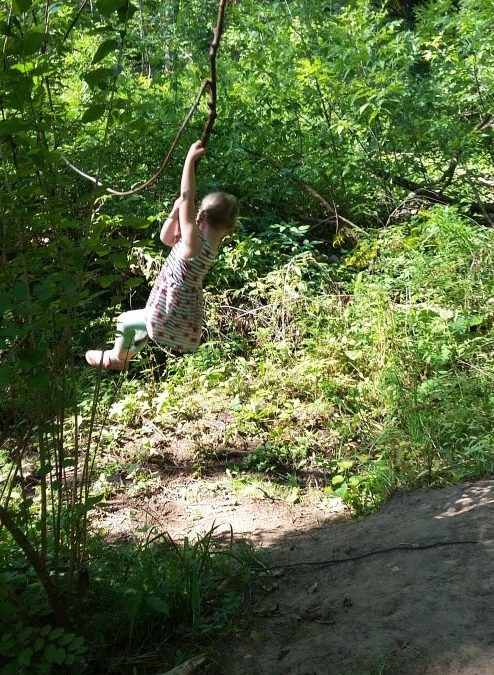From the Author: I’m not sure when I discovered Self-Directed Education, but I do know that it has formed the foundation of my views on education and child development. I find it to be a continuum of many of the respectful parenting/child-care approaches I have been trying to use. I would love for you to read this, my first blog, and learn a little about Self Directed Education, and if this speaks to you, spread the word to others!
“Play is how children learn to take control of their lives” (Gray P. , p. 157). It has become common knowledge that play is significant to healthy child development. Many modern studies and research are confirming that play is an important part of education as well.
In “How Does Learning Happen: Ontario’s Pedagogy for the Early Years” from the Ontario Ministry of Education, the authors state that “[e]vidence from diverse fields of study tells us that… [c]hildren succeed in programs that focus on active learning through exploration, play, and inquiry. Children thrive in programs where they and their families are valued as active participants and contributors” (Ontario Ministry of Education, p. 4). In “The Kindergarten Program 2016”, the authors discovered through extensive research that “…play-based learning emerges as a focal point, with proven benefits for learning among children of all ages, and indeed among adolescent and adult-learners” (Ontario Ministry of Education, p. 10).
These two early year framework documents both align with the foundational points of Self Directed Education. It values that the child is whole and capable, and able to direct their own education, through playing, exploring, inquiring and building positive relationships with both other children and adults. Peter Gray, who is a psychologist from Boston College, has done an extensive amount of research on democratic schools that support this model. He has found that “[e]very time we reduce children’s opportunities for free play by increasing their time at school or other adult-directed activities, we further reduce their opportunities to learn to control their own lives, to learn that they are not simply victims of circumstances and powerful others” (Gray P. , p. 18).
Many parents and educators new to this model may have concerns: how will children learn all that they need to learn? There are schools that have been functioning for many years with documented success. One is the Sudbury Valley School (SVS) in Massachusets, which has been running since 1968. This school ranges in age from 4-18 years old and the “school’s educational philosophy centers on the idea that, in an environment with ample opportunities, children will educate themselves through their own self-directed play and exploration” (Gray Fieldman, p. 109). Gray’s research has shown that even reading can be attained, without formal education. He states that “[a]s long as kids grow up in a literate society, surrounded by people who read, they will learn to read. They may ask questions along the way and get a few pointers from others who already know how to read, but they will take the initiative in all these and orchestrate the entire process themselves” (Gray P. , Children Teach Themselves to Read, 2010). Through the years, studies have been done to follow the success of Sudbury Valley School students, and overall they “have been highly successful in higher education and careers, and most of them attribute much of their success to lessons learned at SVS- lessons about their own interests, abilities and responsibilities” (Gray Fieldman, p. 110).
Organizations are forming to raise awareness and understanding of what SDE is, and try to provide research and education to parents and the community. The Alliance for Self-Directed Education is a nonprofit organization whose “vision, is a world in which Self-Directed Education is embraced as a cultural norm and is available to all children, everywhere, regardless of their family’s status, race or income” (The Alliance for Self-Directed Education , n.d.). They are membership-based and have a lot of resources and information. They also give you access to other organizations and experts that are also supporting the awareness of SDE. Individual citizens, as well as organizations, such as We Learn Naturally, are able to team up and spread awareness.
In conclusion, I believe Self Directed Education to be complementary to the natural style in which children learn. If you’re interested in learning more, I would recommend becoming familiar with the Alliance for Self Directed Education. I would also recommend becoming part of communities that support SDE, such as We Learn Naturally. They have programs that provide this type of learning environment for children of all ages. As well, I recommend you share your feelings and views with others- the more people become aware of the research and experiences, the more common SDE will be.
References
Gray, P. (2010, February 24). Children Teach Themselves to Read. Retrieved from Psychology Today: https://www.psychologytoday.com/blog/freedom-learn/201002/children-teach-themselves-read
Gray, P. (2013). Free to Learn. New York: Basic Books.
Gray, P., Fieldman, J. (2004). Playing in the Proximal Zone of Development. American Journal of Education, 108-145.
Ontario Ministry of Education. (2014). How Does Learning Happen? Ontario’s Pedagogy for the Early Years. Toronto.
Ontario Ministry of Education. (2016). The Kindergarten Program.
The Alliance for Self-Directed Education. (n.d.). Retrieved from https://www.self-directed.org/


Great Piece Erin – I'd love to see a piece from you at some point for how this works as the kids age…..
I've got a couple things in mind for this…that's useful feedback, Anita, thanks!